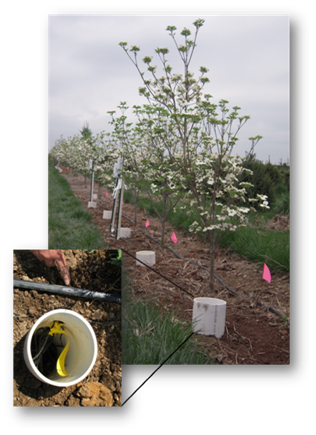You are here
Sensor Networks

A Decagon EM50R network in a Cornus florida block at Raemelton Farm. Insert shows 10HS sensors located in PVC tubes in the root zone.
We established two, four-node wireless sensor networks in two blocks of 'indicator' trees in 2008. We now have three years of data from these networks.
The sensor networks are monitoring the soil water status at two depths (at 6” and 12”) within the root zone of ten Acer rubrum‘Franksred’ Red Sunset® and ten Cornus florida ‘Cherokee Princess’ trees at 15-minute intervals (Picture at right).
These specific blocks of trees were chosen since Acer rubrumrepresent a species with one of the largest water and nutrient requirements on the farm, while Cornus florida represent a slow-growing model species. As such, the average data from the sensors in each block are used to make irrigation scheduling decisions for similar species on a daily basis.
We are also sensing soil temperature, soil electrical conductivity, rainfall, irrigation water applications, air temperature, relative humidity and photosynthetically active radiation (PAR) on a 15-minute time interval in two locations on the farm, to proide daily and seasonal microclimatic data.
